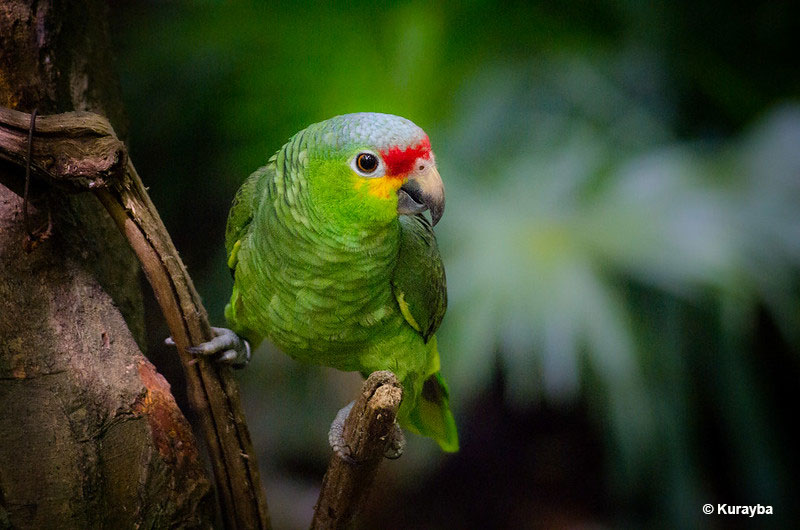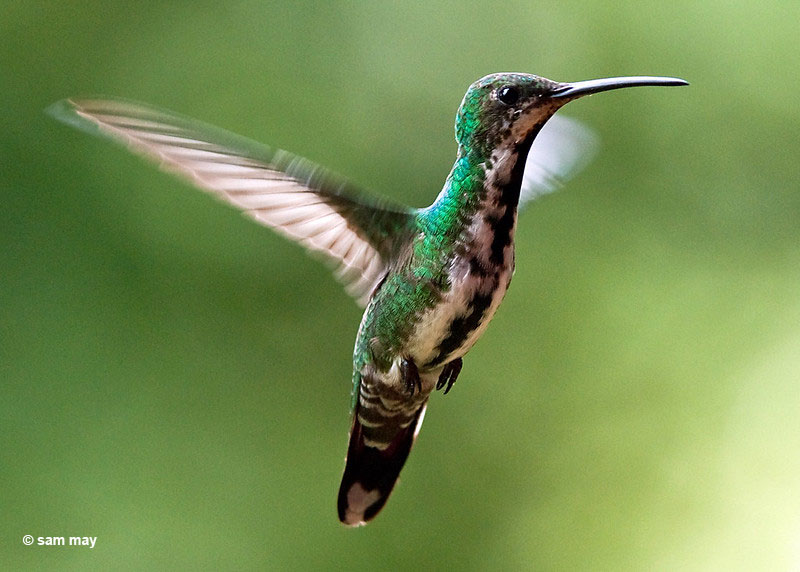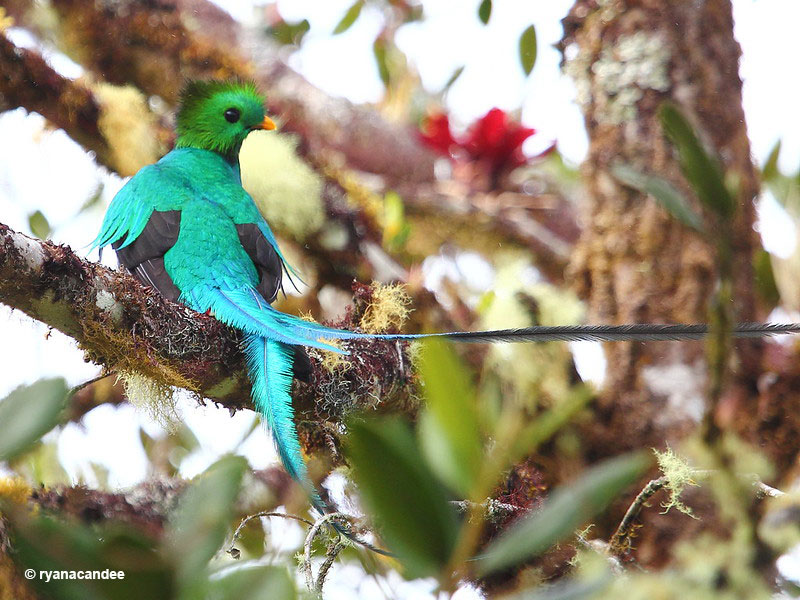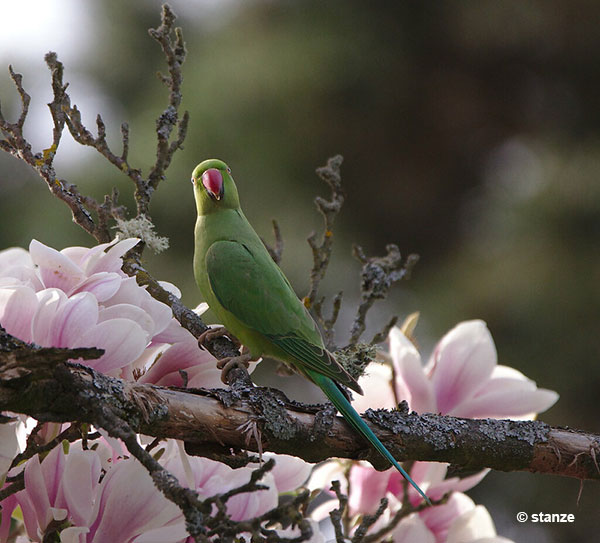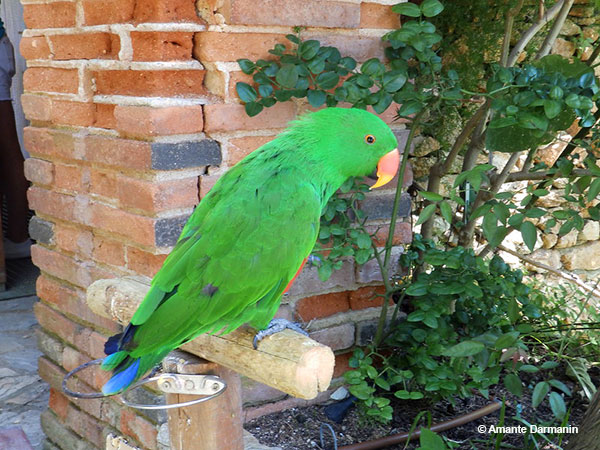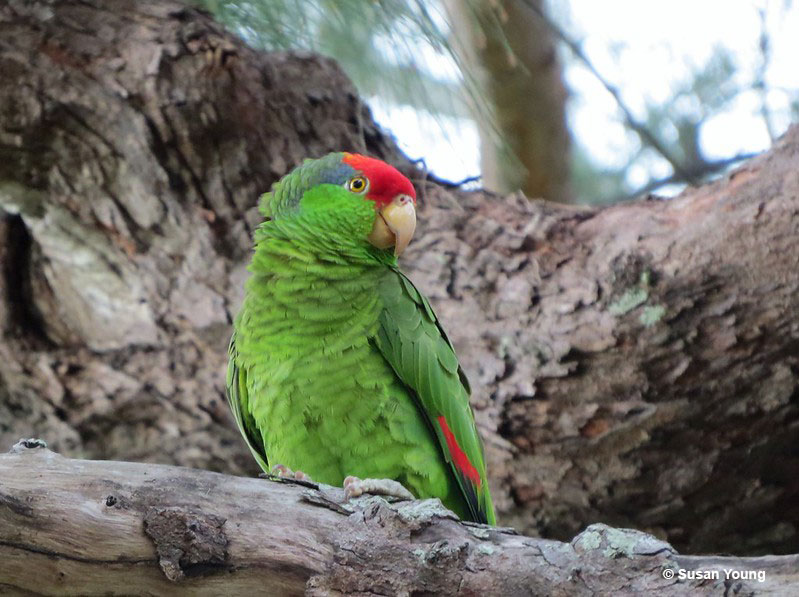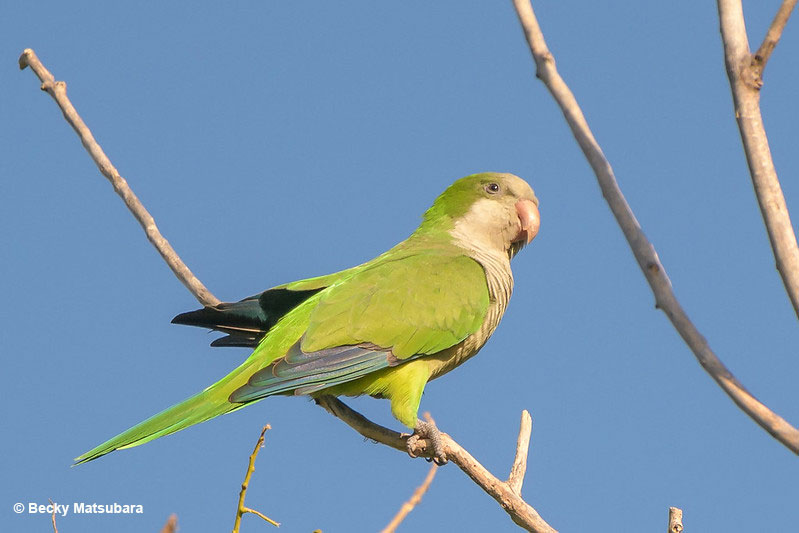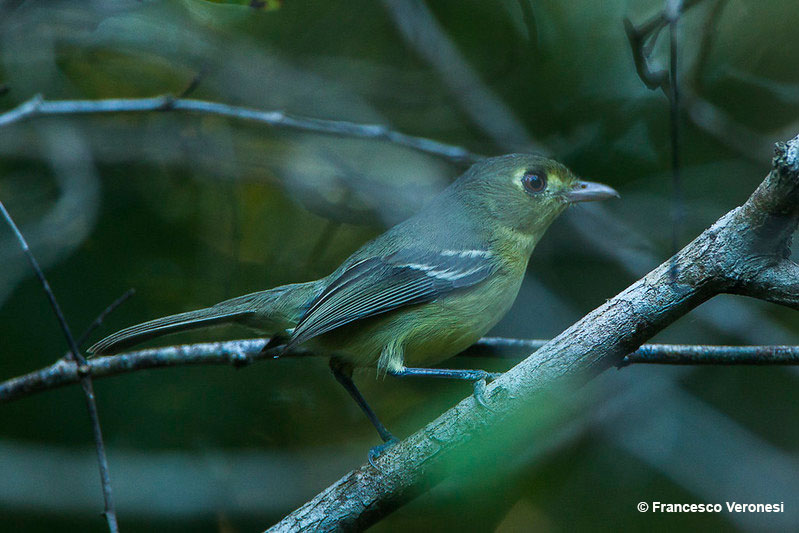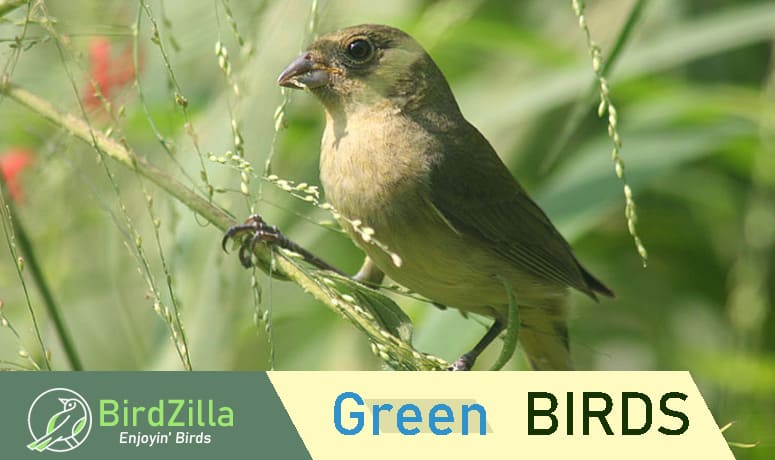
Green birds are widespread and abundant as this coloration is often a means of camouflage to blend in with the surrounding vegetation. However, pure green birds are quite rare and tend to be found in tropical regions.
In this article, we will explore some of the most common green birds, their identifying features and habitats, and share some interesting facts.
Sit back and enjoy!
On this page
- #1 Green Heron
- #2 Red-Lored Amazon
- #3 Green-Breasted Mango
- #4 Resplendent Quetzal
- #5 Rose-ringed Parakeet
- #6 Green Jay
- #7 Green Parakeet
- #8 Tennessee Warbler
- #9 Violet-Green Swallow
- #10 Rivoli’s Hummingbird
- #11 Red-Crowned Parrot
- #12 White-Eyed Vireo
- #13 Orange-Crowned Warbler
- #14 Monk Parakeet
- #15 Cuban Vireo
- FAQ
#1 Green Heron
Butorides virescens
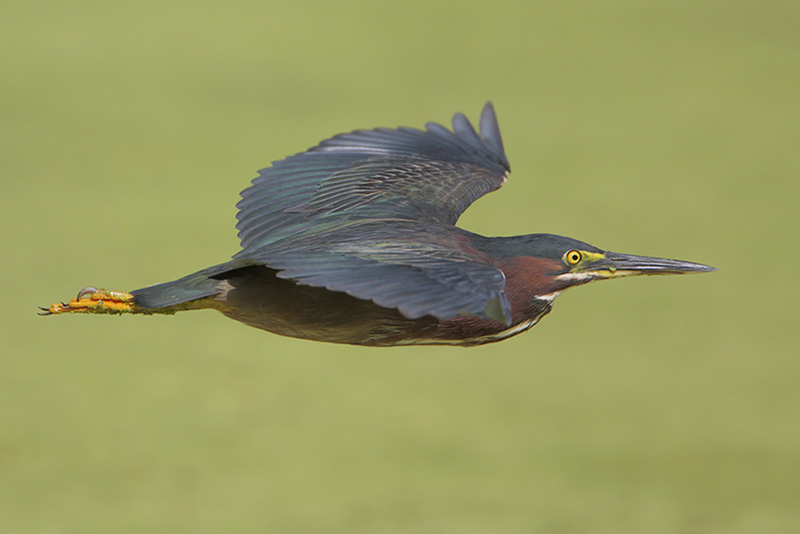
Green Heron in Flight
The Green Heron is a common bird species in North America, although it may be difficult to spot it initially. From afar, it appears dark and stocky, wading on its long slender yellow legs in shallow water.
Close up, it reveals its striking features, including its velvet-green back, chestnut-colored body, and a dark cap that it can raise into a short crest.
- Green Herons use bait, such as bread crusts or insects, to lure small fish near the surface.
- Green Herons may occasionally dive into deep water to catch their prey and then swim back to the shore.
#2 Red-Lored Amazon
Amazona autumnalis
Red-Lored Amazon is a tropical green bird native to the rainforests of Central and South America. They appear all-green at a quick glance but have red on their forehead and wing feathers, and different shades of blue and green on the back of their head and tail.
They’re not an endangered species, but habitat destruction, hunting, and capturing have put their population under threat.
- Red-Lored Amazons are highly intelligent, for example, they test new surfaces using their beaks.
- Red-Lored Amazons are very easily tamed, make good pets, and are good mimics.
#3 Green-Breasted Mango
Anthracothorax prevostii
Green-Breasted Mango is a rather large hummingbird species native to Central and South America. The males are beautiful dark green birds with bright bronze iridescence to their plumage. The females are more modest, sporting a white underside with a black vertical stripe.
They inhabit various semi-open to open landscapes in the lowland tropics, such as mangroves, savannas, and shrublands with trees, but also cultivated areas, such as suburban and urban gardens and parks.
- Green-breasted Mango has four subspecies with differences in appearance and range.
- Although their range doesn’t extend into the United States, some individual birds have strayed into Texas and as far north as Georgia and Wisconsin.
#4 Resplendent Quetzal
Pharomachrus mocinno
The Resplendent Quetzal is a beautiful red and green bird widely recognized for its striking plumage and long tail. It can be found in the tropical forests and cloud forests of Southern Mexico and Central America.
See more: Most Beautiful Birds (in the U.S. & around the world)
The males have iridescent green plumage, a yellow bill, a red lower breast and belly, black innerwings, and a white undertail, while the females are duller, have a gray lower breast, belly, and bill, and shorter tails.
- Resplendent Quetzals are listed as near threatened in the IUCN Red List due to loss of habitat and their subsequent decrease in population.
- In Guatemalan culture, Resplendent Quetzals are associated with Quetzalcoatl, the god of life, winds, knowledge, and light, and are thus considered divine.
#5 Rose-ringed Parakeet
Psittacula krameri
Rose-ringed Parakeet is a species of parrot native to Africa and the Indian subcontinent. It is known for its distinctive green plumage, red beak, and, in males, a distinctive red and black neck ring.
These highly social birds live in flocks, often numbering in the hundreds. In the wild, they are found in a variety of habitats, from forested areas to more urban environments. They feed on fruits, nuts, seeds, and insects, and are known for their acrobatic ability to cling to branches and twigs while they feed.
Related: How Long Do Parakeets Live?
- Birds bred in captivity have developed color mutations, such as turquoise, olive, white, blue, violet, gray, yellow, and cinnamon.
- They are popular pets and due to people releasing them and their adaptations to cold winters, Rose-ringed Parakeets have established feral populations in several European cities.
#6 Green Jay
Cyanocorax luxuosus
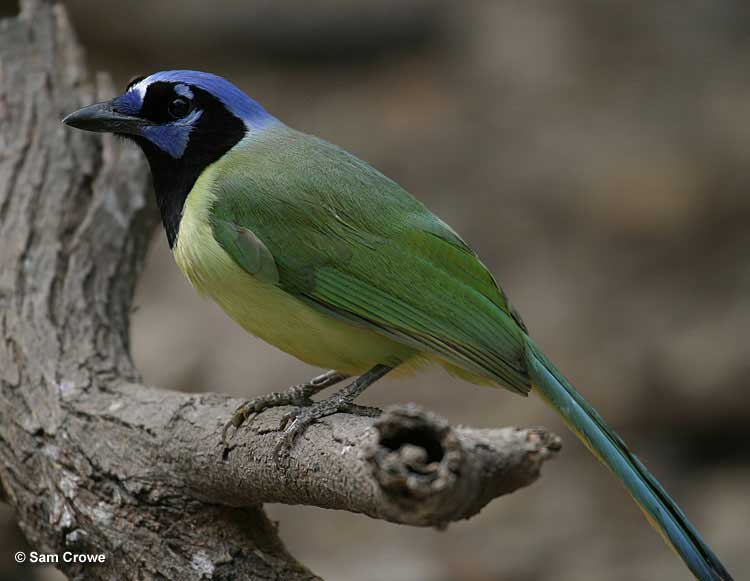
Green Jay is a vocal brightly colored green and yellow bird that is quite easy to identify. They have a green upper side and yellow underside, a blue and black head, and a bluish tinge to their tail.
Green Jays are social birds that travel in family flocks and are typically found in open woodlands and shrubby thickets along waterways in southern Texas. Their range in Texas is small, but it extends south to Honduras, where they inhabit forests and rainforests.
- Green Jays are excellent mimics and may replicate hawk’s calls to scare other birds away from their food source.
- They are also one of the few bird species that use tools; they use sticks to pry up loose bark to reach insects.
#7 Green Parakeet
Psittacara holochlorus
Green Parakeets are medium-sized parrots found throughout Central America, ranging from southern Texas to northern Nicaragua. The adults have all-green plumage with lighter underparts and a yellowish bill.
In the wild, Green Parakeets primarily inhabit tropical and subtropical woodlands, scrubs, swamp forests, and forest clearings. In the United States, the feral populations consisting of escaped pets and their offspring thrive in palm groves in the cities.
- Green Parakeets are cavity nesters, and their nests can be found in tree cavities, holes in buildings, cracks in the rock, and even in termite mounds.
- They’re currently listed as species of least concern in the IUCN Red List, however, their population has been in a decline due to the expansion of farming and capturing.
#8 Tennessee Warbler
Leiothlypis peregrina
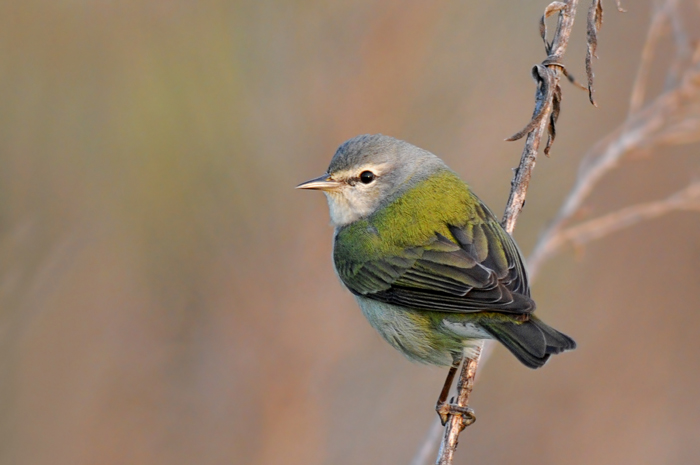
Tennessee Warbler is a yellow and olive-green bird that breeds in eastern North America and winters in Central America. The male has olive shoulders, back, and rump, its head is gray, and its underside is grayish. Females are similar, but much duller in color and tinged with more yellow. You can encounter this bird in forests, groves, brushes, bogs, and swamps.
- Tennessee Warblers nest on the ground but it’s very well concealed thanks to the material of the outer layer.
- Tennessee Warblers “steal” nectar by piercing the flower at the base without helping to pollinate it.
#9 Violet-Green Swallow
Tachycineta thalassina
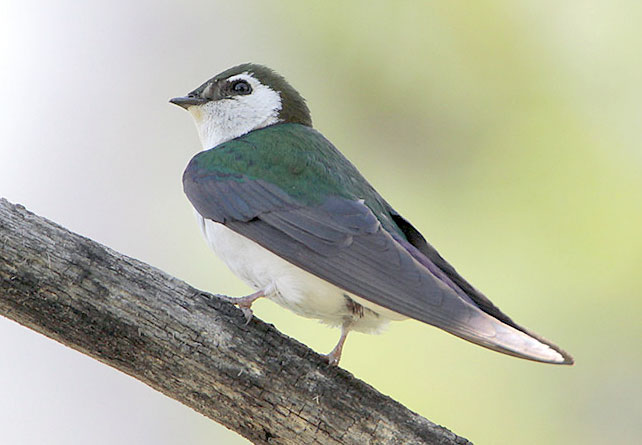
These small green birds show their true beauty and skill while darting through the sky, maneuvering with precision to catch insects.
Violet-Green Sparrows have a dark green back, black wings, head and lower back, and white underside and cheeks. In good light, they have a bronze iridescence on their back and a violet rump. You can meet them in the open and semi-open habitats in the western part of North America.
- Albeit a rare occurrence, Violet-Green Swallows have been observed to hybridize with other species of swallows, such as Tree Swallows, Barn Swallows, and Cliff Swallows.
- Violet-Green Swallows have been observed to cooperate with other species and help them protect their nest site and raise their fledglings.
#10 Rivoli’s Hummingbird
Eugenes fulgens
This green and black bird is the second largest hummingbird north of Mexico. Rivoli’s Hummingbirds are commonly found in most of Central America and the southwestern United States. You can meet them in mountain glades, pine-oak woods, shady canyons, and open hillsides hovering to feed on nectar or flying out to catch small insects.
- Rivoli’s Hummingbirds have some of the fastest heart rates among all vertebrates, with their heartbeats ranging from an astonishing 420 to 1,200 beats per minute.
- A tiny creature known as the hummingbird flower mite hitchhikes on the Rivoli’s Hummingbird, seeking refuge in its nasal passages and jumping off when it reaches the next flower patch.
#11 Red-Crowned Parrot
Amazona viridigenalis
The Red-Crowned Parrot is a big green bird native to a small region in northeastern Mexico with lowland forests and southern Texas. This leaf-green parrot is fairly stocky and has a short tail. As the name suggests, it has a red patch on its forehead. They have red on their wings too, best seen while it’s in flight.
- The Red-Crowned Parrot is listed as endangered on the IUCN Red List due to its already small population decreasing because of habitat loss.
- This bird uses its bill to steady itself while climbing around on branches.
#12 White-Eyed Vireo
Vireo griseus
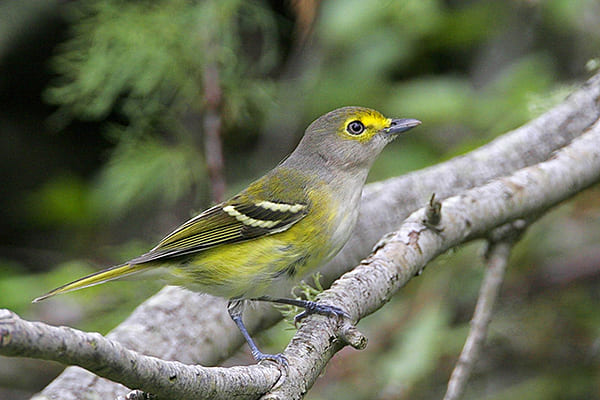
The White-eyed Vireo is a small greenish bird characterized by a thick, straight bill with a slight hook and a gray head that stands out against its olive-green back. The bird’s signature “spectacles,” made up of yellow feathers, frame its pale eye, while its flanks are adorned with a yellow wash.
This bird is a skilled forager, often found in low, dense growth such as shrubby tangles, searching for its preferred food of caterpillars and other insects. It is a common sight in the eastern United States.
- White-Eyed Vireos bathe by rubbing itself against dewy foliage.
- Scientists in Florida have uncovered a 400,000-year-old wing bone belonging to a White-eyed Vireo, dating back to the late Pleistocene era.
#13 Orange-Crowned Warbler
Leiothlypis celata
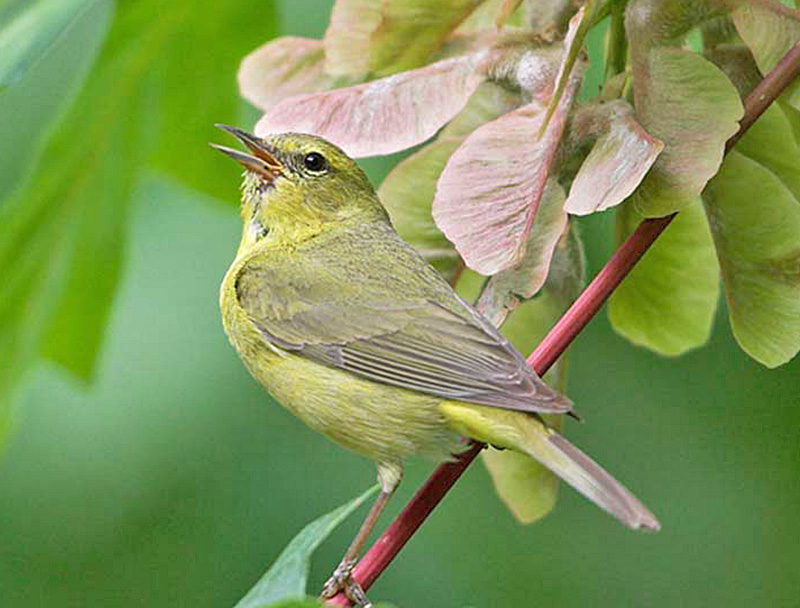
Photograph © Glenn Bartley.
Orange-Crowned Warbler is a little green bird common across all shrubby and brushy areas of North America, with its range extending into Central America. Its upperparts are grayish olive, and its underparts are yellowish with faint streaks. Adults also have an orange patch on their heads, but it isn’t usually visible.
- Orange-Crowned Warblers have four subspecies differing in color, molting patterns, and size.
- The subspecies found in Alaska and Canada is duller and grayer in color, while the one on the Pacific Coast are more yellow. However, the darkest green subspecies are found on the Channel Islands and along the coast of southern California and northern Baja California.
#14 Monk Parakeet
Myiopsitta monachus
The Monk Parakeet is a small, attractive parrot with a distinctive appearance. It has a large head, a long, pointed tail, and an orange, hooked bill. The bird is primarily green with a grayish-white breast and face, making it a stand out among other parakeets.
Originally native to the dry savannas and open woodlands of South America, Monk Parakeets have now established self-sustaining populations in various urban and suburban areas in North America through escape or release from captivity.
- Monk Parakeets are unique among parrots in their tendency to build stick nests in a colonial fashion. Each nest structure typically contains up to 20 chambers and all individuals, including young birds and non-breeders. Everyone contributes to its construction and maintenance using thorny twigs for protection against predators. By doing this, these birds provide a year-round home for the colony.
- They are common pets and can learn to mimic human speech in captivity.
#15 Cuban Vireo
Vireo gundlachii
This small green and yellow bird is native to Cuba but has been seen as a rare visitor in Florida. It is characterized by its “bulging eye” appearance, hefty bill, dull red eyes, dull olive-gray crown, back, and tail, pale yellow to creamy-white eye patch, pale yellowish-gray underparts and cheeks, and bluish-gray legs and feet.
It inhabits dry forests, xeric shrublands, degraded former forests, and lowland moist forests, and prefers thickets and brush. You can see it foraging in the foliage, swallowing smaller prey whole, and ripping larger bugs apart while holding them down with its foot.
- The Cuban Vireo has four subspecies that have differences in their plumage color.
- These birds are common throughout their range and have a variety of habitats. However, they’re also very vulnerable to severe weather, such as hurricanes.
FAQ
What types of birds are green?
Birds that commonly have green in their plumage rely on it to camouflage them from predators. Such species include warblers, vireos, parrots, hummingbirds, and parakeets.
Are green birds rare?
Birds typically have a combination of colors, with green being a frequently occurring hue often serving as camouflage. Purely green feathered birds, however, are a rarity and mostly found in the tropics.
Are there any green birds in North America?
There are many green birds in North America from more modest species such as White-Eyed Vireo, Violet-Green Swallow, and flycatchers to explicitly green birds such as Green Jay and Red-Crowned Parrot.

